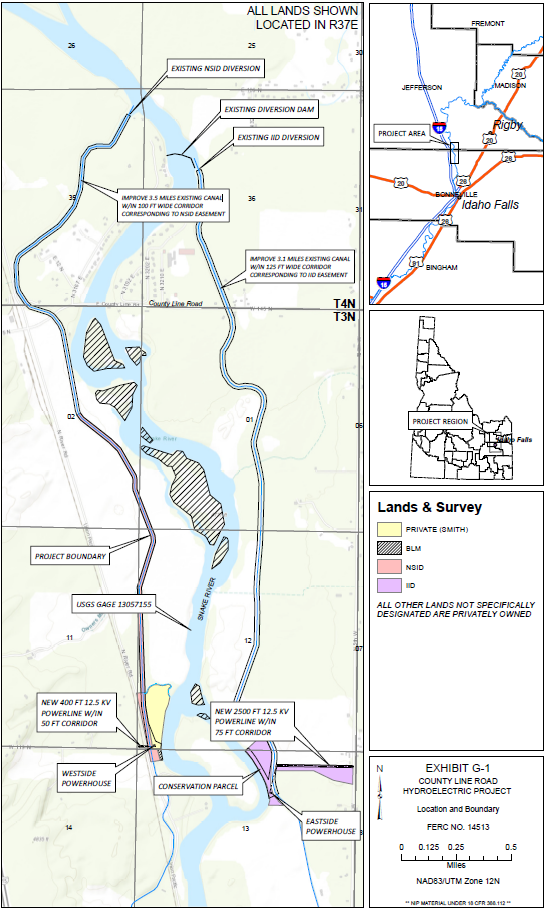Idaho Irrigation District (IID) and New Sweden Irrigation District (NSID) propose to remove water from the Snake River upstream of a dam in Jefferson County, Idaho north of County Line Road and return it to the river approximately 3.5 miles downstream in Bonneville County, Idaho. IID and NSID refer to their combined projects as the County Line Hydroelectric Project (CLHP).
The CLHP consists of two separate hydroelectric projects located on each side of the river, which are shown in Figures 1. Figure 1 does not show buildings over the power plant intake structures and buildings over head gates at the start of the canal. Stakeholders did not have a chance to comment on these buildings because they were not disclosed in the draft license application.
NSID operates the Great Western Canal (west side of the river). Water from the Snake River enters the Great Western Canal upstream of a diversion dam located about one mile north of County Line Road. The Great Western Canal proceeds south along the west side of the Snake River for about 3.5 miles, then heads west away from the river.
IID operates the Idaho Canal (east side of the river). The intake for the Idaho Canal is immediately north of the same diversion dam that provides water to the Great Western Canal. The Idaho Canal proceeds south along the east side of the Snake River for about 3.2 miles, then heads east from the river.
Canal gradients are less than that of the river resulting in 12-15 feet higher water levels in the canals where they come back next to the river 3.5 miles downstream of canal head gates. Applicants propose to install low-head water turbines at these locations to generate power by passing canal water through the turbines with discharge back into the river. The net effect is that turbine feed water is diverted around about 3.5 miles of the Snake River.
A 1.3 megawatt turbine will be installed on the Great Western Canal to produce about 8.4 gigawatts annually (74% of installed capacity). A 1.2 megawatt turbine will be installed on the Idaho Canal to produce about 9.9 gigawatts annually (94% of installed capacity).
IID and NSID have both filed for 1000 cfs (cubic feet per second) of new water allocation from the Idaho Department of Water Resources to feed the CLHP. These requests are for new water allocations for power generation that would be in addition to their existing allocations for irrigation. IID and NSID are proposing to raise the levees along their canal to accommodate simultaneous flow of irrigation and hydroelectric water allocations for at least part of the year.
IID and NSID have jointly filed with the Federal Energy Regulatory Commission for a license to lower flow to 1,000 cfs throughout the section Snake River around which flow will be diverted for turbine feed.
Figure 1: EXHIBIT G-1 from draft license application

